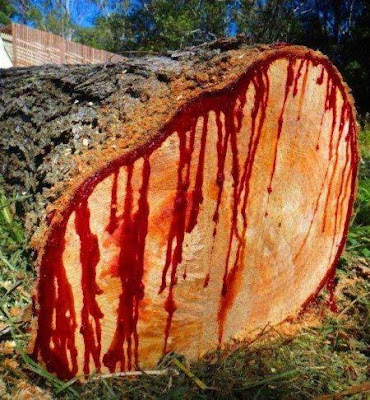How Can A Tree Bleed?
 |
| The Dragon Tree |
Can a tree bleed? The answer is very simple, No. Trees don't have blood like animals that's why they can't bleed. But what if I tell you there is a tree that bleed. You are shocked right? So was I. But there is a tree called Dragon Tree that bleed.
Dragon tree native to the Socotra archipelago, part of Yemen, located in the Arabian Sea. The dragon blood tree has a unique and strange appearance, with an "upturned, densely packed crown having the shape of an uprightly held umbrella".
 |
| Red Sap Of The Tree |
This evergreen species produce a red sap. When the tree is cut this red sap flows out and it looks like blood. So the tree is named after its dark red resin, which is known as "dragon's blood".
 |
| Hercules And Ladon |
There is a mythical story about this tree.
In the Greek view of the world, there was a tranquil garden on the far west that the west came to an end. The garden was inhabited by three nymphs whose special task was to tend an apple tree in the middle of the garden. The golden fruit of the tree would confer immortality upon anyone who ate one. The dragon Ladon always used to coil around the apple tree. Ladon was a hundred-headed uber-dragon. Hercules traveled through the Greek world seeking the garden’s location. According to the myth Hercules killed Ladon to take the apples. As he killed Ladon, it's dark red blood flows through the ground and from this blood the dragon blood tree grew. This tree is believed to have the dragon blood inside
 |
| Red Resin Of Dragon Tree |
Although this tree is a bit awkward but it is very useful in many things. The trees is harvested for their crimson red resin, called dragon's blood. Around the Mediterranean basin it is used as a medicine, Socotrans use it ornamentally as well as dying wool, gluing pottery, a breath freshener, and lipstick. Because of the belief that it is the blood of the dragon it is also used in ritual magic and alchemy. The local inhabitants of the city in the Socotra Island use the dragon's blood resin as a cure-all. Greeks, Romans, and Arabs use it in general wound healing, as a coagulant, cure for diarrhea, for dysentery diseases, for lowering fevers. It is also taken for ulcers in the mouth, throat, intestines and stomach. It was used as a source of varnish for 18th-century Italian violin-makers. It was also used as tooth-paste in the 18th century. It is still used as varnish for violins and for photoengraving.
 |
| Decreasing Number Of Dragon Trees |
Although most of its ecological habitats are still intact, there is an increasing population with industrial and tourism development. This is putting more pressure on the vegetation through the process of logging, overgrazing, woodcutting and infrastructure of development plans. Though the dragon's blood tree is highly widespread, it has become fragmented due to the development that has occurred in its habitats. Many of its populations are suffering due to poor regeneration. Human activities have greatly reduced the dragon's blood population through overgrazing, and feeding the flowers and fruits to the livestock of the island. One of the species' greatest threats is the gradual drying out of the Socotra Archipelago, which has been an ongoing process for the last few hundred years. This has resulted in non flourishing trees, and the duration of the mist and cloud around the area seems to also be decreasing. Increasing arid environments is predicted to cause a 45 percent reduction in the available habitat for D. cinnabari by the year 2080.



Comments
Post a Comment